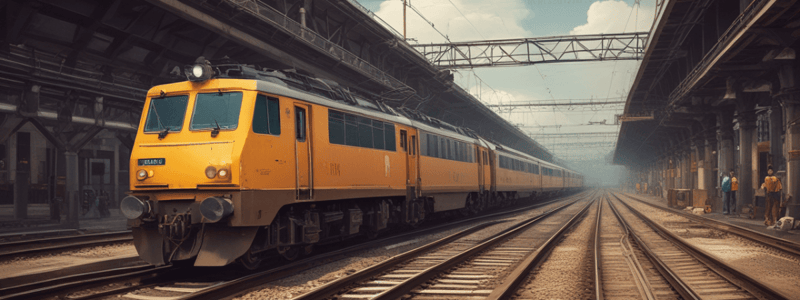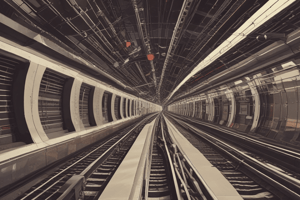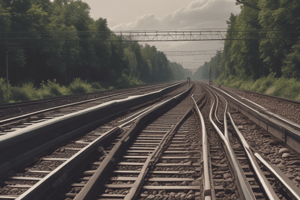Podcast
Questions and Answers
What is the minimum formation width that shall be ensured for new works in both embankment and in cuttings?
What is the minimum formation width that shall be ensured for new works in both embankment and in cuttings?
- 15000 mm
- 12000 mm
- 13160 mm (correct)
- 14000 mm
In doubling work of existing lines, what cross-slope need not be disturbed in the existing old formation?
In doubling work of existing lines, what cross-slope need not be disturbed in the existing old formation?
- 1 in 60
- 1 in 50
- 1 in 30
- 1 in 40 (correct)
Why are suitable dwarf walls provided in case of cuttings?
Why are suitable dwarf walls provided in case of cuttings?
- For aesthetic purposes
- For retaining ballast (correct)
- For draining water
- For supporting the track
Where is super elevation not considered in calculating various dimensions?
Where is super elevation not considered in calculating various dimensions?
When is the cess width on existing track increased on a programmed basis?
When is the cess width on existing track increased on a programmed basis?
What is the purpose of identifying weak formation in tracks?
What is the purpose of identifying weak formation in tracks?
What is the depth of penetration in ballast penetration profile of 'W' shape?
What is the depth of penetration in ballast penetration profile of 'W' shape?
What is the last step in the 4-step action plan for weak formation?
What is the last step in the 4-step action plan for weak formation?
What is the primary purpose of collecting data on the number of attentions to track?
What is the primary purpose of collecting data on the number of attentions to track?
What is the recommended frequency for obtaining ballast penetration profiles?
What is the recommended frequency for obtaining ballast penetration profiles?
What is the significance of identifying the exact nature of present trouble?
What is the significance of identifying the exact nature of present trouble?
Where should undisturbed soil samples be collected from?
Where should undisturbed soil samples be collected from?
What is the purpose of taking two cross sections of the bank?
What is the purpose of taking two cross sections of the bank?
What is the recommended size of sampling tubes for collecting undisturbed soil samples?
What is the recommended size of sampling tubes for collecting undisturbed soil samples?
What is the purpose of collecting data on man-days utilised for maintenance per Km?
What is the purpose of collecting data on man-days utilised for maintenance per Km?
Why are two sections taken in the slipped portion and one section at the toe adjoining the site where slip has not occurred?
Why are two sections taken in the slipped portion and one section at the toe adjoining the site where slip has not occurred?
What is the recommended depth of ballast cushion in the case of curves sharper than 600 M radius for ordinary fish plated track?
What is the recommended depth of ballast cushion in the case of curves sharper than 600 M radius for ordinary fish plated track?
What is the minimum formation width that should be ensured for new works in both embankment and in cuttings?
What is the minimum formation width that should be ensured for new works in both embankment and in cuttings?
What is the cross-slope that shall be provided for new works?
What is the cross-slope that shall be provided for new works?
What is the recommended depth of ballast cushion in the case of curves of radius flatter than 600 M for ordinary fish plated track?
What is the recommended depth of ballast cushion in the case of curves of radius flatter than 600 M for ordinary fish plated track?
What is the volume of ballast cushion required for curves of radius flatter than 600 M for ordinary fish plated track with a depth of 350 mm?
What is the volume of ballast cushion required for curves of radius flatter than 600 M for ordinary fish plated track with a depth of 350 mm?
What is the recommended depth of ballast cushion in the case of curves sharper than 600 M radius for short welded panel track?
What is the recommended depth of ballast cushion in the case of curves sharper than 600 M radius for short welded panel track?
What is the recommended gauge sleeper for PRC with a gauge of 1676 mm?
What is the recommended gauge sleeper for PRC with a gauge of 1676 mm?
What is the volume of ballast cushion required for curves of radius sharper than 600 M for ordinary fish plated track with a depth of 250 mm?
What is the volume of ballast cushion required for curves of radius sharper than 600 M for ordinary fish plated track with a depth of 250 mm?
What is the purpose of T-696 to 699 fish plates?
What is the purpose of T-696 to 699 fish plates?
What type of sleeper is used for Guard Rail on Bridge and approach?
What type of sleeper is used for Guard Rail on Bridge and approach?
What is the purpose of RDSO/T-2572 Glued Insulated Rail Joint?
What is the purpose of RDSO/T-2572 Glued Insulated Rail Joint?
What is the purpose of RT-7014 to 7021 nylon cord reinforced GRSP?
What is the purpose of RT-7014 to 7021 nylon cord reinforced GRSP?
What type of sleeper is used for Re-Railing Ramp On 52 Kg Running Rail?
What type of sleeper is used for Re-Railing Ramp On 52 Kg Running Rail?
What is the purpose of T-2495 and T-2496 fish plates?
What is the purpose of T-2495 and T-2496 fish plates?
What is the purpose of RT-5848 and RT-5849 joggled fish plates?
What is the purpose of RT-5848 and RT-5849 joggled fish plates?
What type of sleeper is used for SEJ?
What type of sleeper is used for SEJ?
What is the primary purpose of bores made at the top of Embankment, Mid Slope of Embankment, and near Toe?
What is the primary purpose of bores made at the top of Embankment, Mid Slope of Embankment, and near Toe?
What is the significance of soil testing in determining remedial measures for slope failure?
What is the significance of soil testing in determining remedial measures for slope failure?
What is the purpose of referring to RDSO's guidelines/specifications for Earthwork?
What is the purpose of referring to RDSO's guidelines/specifications for Earthwork?
What is the purpose of making one set of bores from an adjoining stable bank?
What is the purpose of making one set of bores from an adjoining stable bank?
What is the primary function of insulated joints in track circuited sections?
What is the primary function of insulated joints in track circuited sections?
What is the significance of past failure history in determining remedial measures for slope failure?
What is the significance of past failure history in determining remedial measures for slope failure?
What is the primary purpose of providing adequate drainage arrangement in slope protection?
What is the primary purpose of providing adequate drainage arrangement in slope protection?
What is the significance of site investigation in determining remedial measures for slope failure?
What is the significance of site investigation in determining remedial measures for slope failure?
Study Notes
Ballast Cushion and Formation
- Ballast cushion depth varies depending on the radius of the curve:
- For curves flatter than 600 M radius, the depth is 1.769 M3 (250 mm), 2.022 M3 (300 mm), and 2.282 M3 (350 mm).
- For curves sharper than 600 M radius, the depth is 1.820 M3 (250 mm), 2.078 M3 (300 mm), and 2.344 M3 (350 mm).
- In the case of ordinary fish-plated track, the ballast cushion depth should be increased to 400 mm on the outside of curves sharper than 600 M radius.
- In short welded panel track, the ballast cushion depth should be increased to 400 mm on the outside of all curves flatter than 875 M radius and to 450 mm in curves sharper than 875 M radius.
- In curves of turnouts in passenger yards, the ballast cushion depth should be increased to 550 mm on the outside of turnouts.
Gauge Sleeper
- The dimensions of gauge sleeper vary depending on the type of sleeper:
- PRC sleeper: 250 mm, 350 mm, and 500 mm
- Other types of sleepers: 2785 mm, 2943 mm, 13160 mm, 707 mm, 5300 mm, and 1676 mm
Formation Classification and Treatment
- Formation requiring treatment should be classified based on the following conditions:
- Stretches having speed restrictions due to weak formation
- Stretches where more than normal track attention is required
- Stretches where ballast penetration profile is of 'W' shape and maximum depth of penetration is more than 30 cm
- The 4-step action plan for weak formation includes:
- Making the formation width, cess level, and side drains strictly in accordance with prescribed profile
- Carrying out shallow screening of ballast section (or deep screening where required)
- Ensuring no loose or missing fitting
- Cracks on the cess
Soil Investigation and Testing
- Soil investigation should be carried out to identify the nature of the present trouble:
- Undisturbed soil samples should be collected at every hectometer/O.H.E. mast
- Soil samples should be collected from various depths and locations, including the formation below the depth up to which the ballast has penetrated
- Two cross-sections of the bank should be taken by means of precise levelling
- Remedial measures should be decided based on site investigation, soil testing, and past failure history
Insulated Joints and Switch Expansion Joints
- Insulated joints are used to electrically insulate track circuited sections:
- Description of insulated joints
- Types of insulated joints, including fish-plate EDO/T-2242, joggled fish plates, and combination fish plates
- Switch expansion joints are used to accommodate the expansion and contraction of rails:
- Description of switch expansion joints
- Types of switch expansion joints, including PSC sleepers and nylon cord reinforced GRSP
Studying That Suits You
Use AI to generate personalized quizzes and flashcards to suit your learning preferences.
Related Documents
Description
Calculate ballast cushion volumes for railway tracks with different radii and plate types. Important for railway engineering and track construction.




